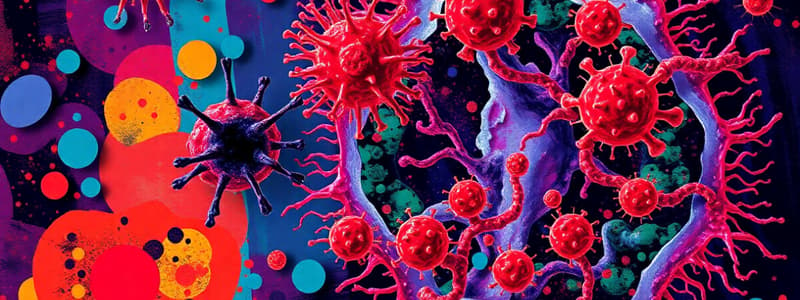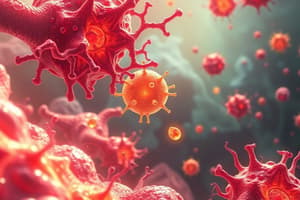Podcast
Questions and Answers
What is the primary function of superantigen toxins?
What is the primary function of superantigen toxins?
- Stimulate a large immune response and inflammation (correct)
- Bind specifically to internal cellular components
- Directly damage host cell membranes
- Inhibit the production of antibodies
Which of the following best describes the mechanisms by which cytokines are released during an immune response?
Which of the following best describes the mechanisms by which cytokines are released during an immune response?
- Cytokines are primarily produced by cytolytic toxins
- Cytokines inhibit leukocyte activity
- Cytokines facilitate communication between immune cells (correct)
- Cytokines promote cell lysis and regeneration
Which characteristic is NOT typical of endotoxins?
Which characteristic is NOT typical of endotoxins?
- Composed of lipopolysaccharides
- Triggered by the death of bacteria
- Associated with systemic inflammation
- Synthesized by specific bacteria (correct)
How do cytotoxic T-cells primarily respond to toxins in the context of autoimmune diseases?
How do cytotoxic T-cells primarily respond to toxins in the context of autoimmune diseases?
What role do A-B toxins play in cellular damage?
What role do A-B toxins play in cellular damage?
What impact do neurotoxins have on the nervous system?
What impact do neurotoxins have on the nervous system?
What is a primary consequence of excessive cytokine release during an immune response?
What is a primary consequence of excessive cytokine release during an immune response?
Which of the following is characteristic of cytolytic toxins?
Which of the following is characteristic of cytolytic toxins?
How can the immune system respond to exotoxins effectively?
How can the immune system respond to exotoxins effectively?
What specific role do lipases play among the cytolytic toxins?
What specific role do lipases play among the cytolytic toxins?
What characteristic primarily distinguishes endotoxins from exotoxins in terms of toxicity?
What characteristic primarily distinguishes endotoxins from exotoxins in terms of toxicity?
What is the role of Limulus amebocyte lysate (LAL) in detecting endotoxins?
What is the role of Limulus amebocyte lysate (LAL) in detecting endotoxins?
What is one of the major clinical problems associated with endotoxins?
What is one of the major clinical problems associated with endotoxins?
Which of the following correctly represents the relationship between endotoxin concentration and lethal dose in mice?
Which of the following correctly represents the relationship between endotoxin concentration and lethal dose in mice?
What are some common conditions associated with endotoxemia?
What are some common conditions associated with endotoxemia?
What is a significant limitation of the Limulus test for endotoxins?
What is a significant limitation of the Limulus test for endotoxins?
What percentage of intensive care patients are estimated to have endotoxemia?
What percentage of intensive care patients are estimated to have endotoxemia?
How are endotoxins primarily produced in the context of bacterial infections?
How are endotoxins primarily produced in the context of bacterial infections?
What is a common symptom of endotoxin exposure?
What is a common symptom of endotoxin exposure?
Which is NOT a type of response related to endotoxins?
Which is NOT a type of response related to endotoxins?
What is the primary mechanism by which superantigen toxins affect T cells?
What is the primary mechanism by which superantigen toxins affect T cells?
Which consequence is primarily associated with endotoxin exposure?
Which consequence is primarily associated with endotoxin exposure?
What role does Fragment A play in A-B toxins such as diphtheria toxin?
What role does Fragment A play in A-B toxins such as diphtheria toxin?
Which statement accurately describes a characteristic of endotoxins?
Which statement accurately describes a characteristic of endotoxins?
How do superantigens contribute to the risk of autoimmune diseases?
How do superantigens contribute to the risk of autoimmune diseases?
Which of the following is NOT a symptom associated with endotoxin exposure?
Which of the following is NOT a symptom associated with endotoxin exposure?
What type of immune response can result from cross-reactive antibodies triggered by certain bacterial infections?
What type of immune response can result from cross-reactive antibodies triggered by certain bacterial infections?
What is a significant effect of cytokines released due to superantigen activation?
What is a significant effect of cytokines released due to superantigen activation?
Which of the following correctly distinguishes alpha-hemolysis from beta-hemolysis?
Which of the following correctly distinguishes alpha-hemolysis from beta-hemolysis?
What do the lipopolysaccharide (LPS) components of endotoxins primarily trigger in the host?
What do the lipopolysaccharide (LPS) components of endotoxins primarily trigger in the host?
Flashcards
Beta-hemolysis
Beta-hemolysis
Complete lysis of red blood cells, creating a clear zone around bacterial colonies on blood agar.
Alpha-hemolysis
Alpha-hemolysis
Partial lysis of red blood cells, creating a greenish zone around bacterial colonies on blood agar.
A-B toxins
A-B toxins
Bacterial toxins composed of two parts: an active (A) subunit and a binding (B) subunit that targets host cells.
Diphtheria toxin
Diphtheria toxin
Signup and view all the flashcards
Tetanus toxin
Tetanus toxin
Signup and view all the flashcards
Botulinum toxin
Botulinum toxin
Signup and view all the flashcards
Superantigens
Superantigens
Signup and view all the flashcards
Toxic shock syndrome toxin
Toxic shock syndrome toxin
Signup and view all the flashcards
Endotoxins
Endotoxins
Signup and view all the flashcards
Lipopolysaccharide (LPS)
Lipopolysaccharide (LPS)
Signup and view all the flashcards
Septic shock
Septic shock
Signup and view all the flashcards
Pyrogens
Pyrogens
Signup and view all the flashcards
Exotoxins
Exotoxins
Signup and view all the flashcards
Neurotoxins
Neurotoxins
Signup and view all the flashcards
Enterotoxins
Enterotoxins
Signup and view all the flashcards
Cytotoxins
Cytotoxins
Signup and view all the flashcards
A-B Toxins
A-B Toxins
Signup and view all the flashcards
Cytolytic Toxins
Cytolytic Toxins
Signup and view all the flashcards
Superantigens
Superantigens
Signup and view all the flashcards
Phospholipases
Phospholipases
Signup and view all the flashcards
Pore-forming Toxins
Pore-forming Toxins
Signup and view all the flashcards
Leukocidins
Leukocidins
Signup and view all the flashcards
Hemolysins
Hemolysins
Signup and view all the flashcards
Streptolysin-O
Streptolysin-O
Signup and view all the flashcards
Streptolysin-S
Streptolysin-S
Signup and view all the flashcards
Endotoxin Toxicity
Endotoxin Toxicity
Signup and view all the flashcards
Endotoxin LD50
Endotoxin LD50
Signup and view all the flashcards
Exotoxin LD50
Exotoxin LD50
Signup and view all the flashcards
Endotoxins and TSS
Endotoxins and TSS
Signup and view all the flashcards
Limulus Test
Limulus Test
Signup and view all the flashcards
Endotoxemia
Endotoxemia
Signup and view all the flashcards
Endotoxemia examples
Endotoxemia examples
Signup and view all the flashcards
Limulus Test Limitations
Limulus Test Limitations
Signup and view all the flashcards
Study Notes
Virulence Factors - Toxins
- Virulence factors include adhesions, exoenzymes (some act as toxins), exotoxins, and metabolic pathways.
- Exotoxins are synthesized by specific bacteria, including toxin genes found on plasmids or prophages.
- Exotoxins are among the most lethal substances known, with a small LD50.
- Exotoxins are highly immunogenic, stimulating the production of neutralizing antibodies (antitoxins).
- Exotoxins can be inactivated to form toxoids, and passive immunity in the form of antitoxin can be used for treatment.
- Exotoxins can be grouped into functional categories, such as neurotoxins, causing nervous system damage and paralysis, tissue-specific enterotoxins (damaging intestines and digestive tract tissues), and cytotoxins, damaging various cells and tissues.
- Exotoxins are released extracellularly and can travel far from the infection site.
- Cytolytic toxins attack cell components causing lysis, while A-B toxins (with a binding subunit 'B' and a toxic 'A' subunit) are site-specific and can disrupt membranes.
- Superantigen toxins stimulate a large immune response and subsequent inflammation.
Cytolytic Toxins
- Two main types of cytolytic toxins are lipases and phospholipases (lecithinases).
- Pore-forming toxins like leucocidins and streptolysins create pores in cell membranes.
- Other cytolytic toxins, such as phospholipases, remove polar heads from phospholipids, destabilizing the membrane, and causing cell lysis.
- An example is Clostridium perfringens.
Pore-forming Exotoxins
- Leukocidins kill phagocytic leukocytes.
- Hemolysins kill erythrocytes, leukocytes, and other cells.
- Examples include streptolysin-O (SLO) and streptolysin-S (SLS), with SLO being oxygen-sensitive and SLS being oxygen-stable.
- Staphylococcus aureus produces an example of a pore-forming toxin.
A-B Toxins
- A-B toxins are composed of two parts: A and B subunits.
- The B subunit binds to specific host cell receptors, facilitating entry.
- The A subunit is the toxic or active part.
- The structure of A-B toxins offer novel approaches for vaccine and therapy, as their structure can be used for binding and delivery systems.
- Ex: Diphtheria toxin (Corynebacterium diphtheriae) inhibits protein synthesis by preventing tRNA binding to ribosomes. Rats/mice are resistant, but humans are susceptible to the toxin.
- Other A-B toxins such as tetanus toxin and botulinum toxin are produced from Clostridium bacteria. Botulism toxin prevents muscle contraction while tetanus toxin prevents muscle relaxation.
Superantigen Toxins
- Superantigens elicit a very strong immune response by inducing the extensive release of cytokines.
- This leads to a systematic inflammatory response, resulting in symptoms like vomiting, diarrhea, and fever.
- Superantigens can also contribute to autoimmune diseases.
- Examples include Toxic Shock Syndrome Toxin (TSST-1), staphylococcal and streptococcal toxins, staphylococcal enterotoxin A (produced by Staphylococcus aureus), scarlet fever toxin (produced by Streptococcus pyogenes).
Immune Responses
- Immune responses can be damaging, with antigen-antibody complexes settling in joints and kidneys causing destructive inflammation.
- Cross-reactive antibodies bind to the body's own tissues, promoting autoimmune responses.
- Streptococcus pyogenes can cause rheumatoid arthritis as an example.
Endotoxins
- Endotoxins are components of gram-negative bacteria (LPS, Lipid A).
- They are released when gram-negative cells are lysed, and they are heat-stable.
- Endotoxin symptoms include fever resulting from pyrogen release, diarrhea, and inflammation.
- They are not suitable for use as toxoids.
- Endotoxins play a significant role in septic shock.
How Endotoxins Compare to Exotoxins
- Endotoxins are less toxic than exotoxins, with much higher LD50 amounts.
- Endotoxins can still contribute to clinical problems, and their presence can significantly increase the sensitivity to other toxins, such as TSS toxins,
- The presence of endotoxin can increase sensitivity to TSS toxins up to a million-fold.
Limulus Test
- Limulus amebocyte lysate (LAL) is used as a presumptive test for endotoxin. This test uses amoebocytes from horseshoe crabs.
- The blood or lysate clots in response to endotoxins.
Endotoxemia
- Endotoxemia is often associated with bacterial infections and severe wounds with high significance in intensive care units.
Problems with Limulus Test
- The Limulus test can't discriminate between live or dead cells, or toxin types of different species.
Additional Questions
- Endotoxin definition, bacterial source, symptoms, and assay methods are addressed in the text.
- This text notes that next time, diseases will be discussed.
Studying That Suits You
Use AI to generate personalized quizzes and flashcards to suit your learning preferences.
Related Documents
Description
Explore the critical role of virulence factors, focusing on exotoxins and their interaction with host systems. This quiz will test your knowledge about toxins, their effects, types, and treatment options. Understand how exotoxins contribute to bacterial pathogenicity and the immune response they elicit.




